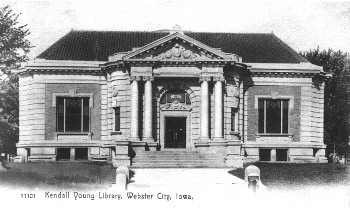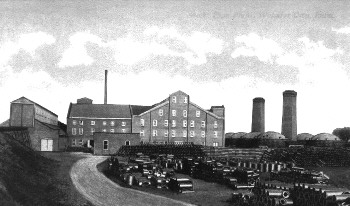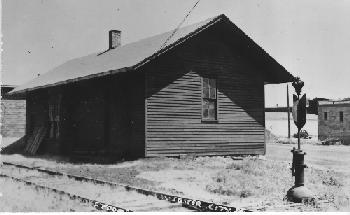Webster City - 1857 to the present
By Martin E. Nass
Transcribed for the IAGenWeb Project by Janelle Martin, with permission of Martin "Ed" Nass.
Additional Links at Bottom of Page! (Theaters, Schools, etc.)


Webster City - City Hall (1901-1971) ----------------Kendall Young Library
(built 1904)
Wilson Brewer moved his family from Hope Hollow, where they had stayed for
one year. This was in the area later to be called Bone's Mill. He built a
cabin on the creek, west of the Boone River. This creek became known as Brewers
Creek. On October 27, 1854, Brewer, along with William Frakes, platted the
town of Newcastle. He named it for Highcastle-on-the-James, Virginia, where
he came from. He often referred to his town as Newcastle-on-the-Boone. This
eight block plat had streets First, Second, Third and Fourth and were divided
by Superior, Main, and River Streets running north-south. Main later became
an extension of Union Street.

Walter C. Willson came to Newcastle
in 1855 with his brother, Sumler. They purchased the entire plat of Newcastle
from Wilson Brewer for $22,000. They then set about building a town. Walter
did most of the building and then left the operation to Sumler. First he
built a sawmill at the east end of Ohio Street. Later he added a corn cracker
to grind corn. Finally it was converted to a flour mill. Willson then built
his first hotel, a log building which was constructed near the present
intersection of the Chicago & Northwestern tracks and Second Street.
Next Willson built a frame hotel at the southwest corner of the intersection
of Bank and Seneca Streets. This he called the Willson House. It would later
be called the American House, and much later as the Park Hotel. This hotel
was across the street from the Public Square, today called West Twin Park.
Willson arranged to get a post office established on October 9, 1855 with
the name Webster City Post Office. The town was still called Newcastle at
the time, but Willson had his plans. The first postmaster was J. J. Wadsworth.
Soon this post office was located across from the hotel in the L. L. Estes
Drug Store. Willson also arranged for the Western Stage Line to run the
stagecoach through Newcastle and on to Fort Dodge, eliminating the need for
the line from Boone to Hook's Point and Homer, and then to Fort Dodge.
Surprisingly, he arranged for the stage stop in Newcastle to be at his hotel,
The Willson House.
As was related in the Hamilton County section on the Home Page you learned
that Walter C. Willson conspired with John F. Duncombe to wrest the county
seat from Homer and Burkley Granville, its main promoter. They were successful
in the election results, so Willson was elected to be the state representative
for the sole purpose of introducing legislation to divide the huge Webster
County into two parts, the east part to be named Sharon and have Webster
City (Newcastle) become the county seat. Willson rode a mule to Marengo and
took the stage coach to Iowa City for his duties. He enlisted the aid of
William W. Hamilton to get his act passed. To recognize the assistance Hamilton
gave him, he entered the name Hamilton as our new county name. This act also
renamed Newcastle as Webster City. This act took effect on January 1, 1857.
There are three different ideas as to why he chose the name Webster City.
One was that he named it for the popular stage coach driver who stopped at
his hotel. Another was to recognize our connection to Webster County and
name it for that county name. The last idea is that he named it for Daniel
Webster, the noted national orator who was so respected by the people. It
is interesting to note that the city and the man who did so much to develop
our town bear the same initials, W. C.
Willson did not stop here. He realized that for the town to succeed he needed
to get a railroad to pass through here. He worked tirelessly for many years
trying to get the Dubuque and Pacific Railroad to come. That line had several
starts and stops to get organized. At one point Willson grew discouraged
and went to Chicago to engage in the lumber business.
When Willson returned from Chicago , he met with John I. Blair who had by
now directed the Dubuque & Sioux City Railroad as far west as Alden.
Blair needed a person to direct the construction of his railroad, and he
persuaded Willson to take it over. When Willson protested that he wanted
to build another hotel, Blair told him that he would pay him more. Willson
then got together a crew and laid the tracks into Webster City. The townspeople
expected him to stop at Seneca and put the depot there. Instead, he continued
to Des Moines Street and put the depot there. He drained the swampy area
between the depot and Second Street. Then he continued building the line
all the way to Fort Dodge, covering the distance in only 30 days. That was
an unheard of record for laying track. He intended to stop at Fort Dodge,
but Blair told him that if he took the line all the way to Storm Lake he
would pay him enough to build his new hotel.
When Willson finished with the railroad, he returned to Webster City and
built his fine two story hotel "Willson House" at the corner of Second and
Des Moines Streets. This made about half of the townspeople very unhappy,
as most of the business was located on Seneca. Willson persuaded some of
this friends to buy land and put in business blocks on Second. This they
did. Previously, when Willson was kicked out of his own hotel, now called
the American House, he vowed that he would move the business district with
him and let "grass grow on Seneca." Willson ran a bus from the hotel to the
depot to meet all trains. He also built an opera house on the opposite corner
from the hotel. As usual, Walter would build and then Sumler would manage
things for him.

National Sewer Tile Plant
Realizing that the area here needed draining, Willson decided that we
needed to get coal and clay here to construct tile for the farmers. In
cooperation with Fred Fuller, Jacob Funk, and S. B. Rosencrans, he went to
the Lehigh area and opened a coal company on the banks of Crooked Creek.
Willson then constructed a narrow gauge railroad from Lehigh to Webster City,
passing through Flugstad. He hauled coal and clay to Webster City, with a
stop at the National Sewer Tile Company, a company the four men built up
to make the tile. It was located across the street from the former drive
in theater on West Second Street. The railroad had the official name of Webster
City and Southwestern Railroad, but it went mostly by the name of the Crooked
Creek Railroad.

Willson continued to build in Webster City. Altogether he constructed 133
buildings, four hotels, three railroads, and contributed more to the success
of Webster City than any other man. In August, 1900, Willson was supervising
the unloading of slag at a low spot on the line near the intersection of
Third and Funk. A car that was being unloaded tipped over and crushed him
to death. His funeral was the largest funeral ever held in Webster City.
Special trains brought the miners from Lehigh; others carried over his Fort
Dodge friends. Sumler continued to manage the various businesses but then
he, too, was killed when his horse bolted and threw him.
While Willson gave the town its life, many others have taken over to supervise
the growth of this town. Jacob Funk, J. D. Sketchley, S. B. Rosencrans, Kendall
Young, L. L. Estes, and so many more have given this community so very much.
Of special note we need to recognize two men who grew up here and became
our famous Pulitzer Prize winning authors. MacKinlay Kantor was born here
in 1904 and wrote over forty novels. Andersonville won the Pulitzer
Prize for Literature in 1956. Clark Mollenhoff was graduated from Webster
City High School and Webster City Junior College. He wrote for the Des
Moines Register and was its Washington bureau chief for several years.
He won the Pulitzer Prize in 1958 for National Reporting. He was the author
of ten books. Both men were honored in 1976 with a program dedicating the
Kantor-Mollenhoff Plaza in West Twin Park.
The population of Webster City in the 1990 census was 7,894. The county
population was 16,071. There is so much more to learn of Webster City than
I can possibly put here. Consult the Kendall Young Library whose staff will
be most helpful in directing you to the many good books about Webster City.
Additional links to the history of Webster City
- To find out about the theaters in our Webster City history click on the word
Theaters.
- To find out about the public schools of our city click on the word
School.
- To find out about the colleges that Webster City has had click on the
word College.
- To find out about the city government of our city click on the word
Government.
- To find out about the parks and recreation in our city click on the word
Parks.
- To find out about the churches of our city click on the word
Church.
- To find our about the seven burial grounds of Webster City click on the word
Cemetery.
- To look at some general pictures of former buildings and scenes in Webster
City click on Pictures.
|
|